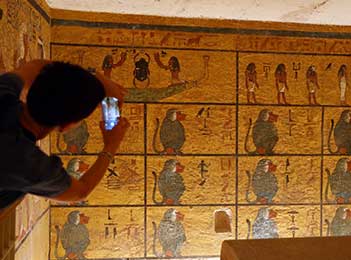Valley of the Kings Location
Situated under beneath the highest peak in the Theban Mountains of the West Bank of Luxor, near the Temple of Hatshepsut , the Pharaohs have chosen the location of the Valley of the Kings carefully.
However, this never stopped the robberies of the tombs, as all the tombs of the valley were robbed except that of King Tut Ankh Amun which was discovered intact in 1922 by Howard Carter as the most important antiquities discovery in the 20th century.
Tourists spending their holidays in Egypt can reach the West Bank of Luxor by a ferryboat and then take a taxi to reach the Valley of the Kings. However, it is almost recommended for tourists to book it though a travel agency when they visit Egypt as they are well organized and save a lot of time, effort, and hassle.
Valley of the Kings History
The ancient Egyptians, according to historical records, have resided in the West Bank of Luxor, as early as the Middle Stone Age. One of the reasons why ancient Egyptians have chosen this exact location to establish their glorious necropolis is the pyramid shaped mountain peak that seems like a pyramid while entering the valley.
After Ahmos I defeated the Hyksos at the end of the 16th century BC, the kings of Thebes decided it is time to establish a glorious necropolis for them so they started to use the Theban Mountains under the pyramid shaped peak to dig their tombs.
According to scholars, the first king to be buried in the Valley of the Kings was Amenhotep I and Tuthmosis I at the end of the 16th century BC. However, some other historical theories claim that Ahmos I and his son were buried in the Valley of the Kings more than 50 years before the other two tombs. However, these tombs are not unearthed until today.
The Valley of the Kings that contains no less than 63 tombs was used until the year 1075 with Ramses X or XI being the last king to be buried there. However, many other people, other than the king, were buried in the Valley of the Kings after this period.
The Description of the Valley of the Kings
The Valley of the Kings today has turned into one of the most popular touristic attractions visited by numerous tourists who travel to Egypt.
The tourists enter from the gate to the South, take an open-air bus to reach the location of the Valley, and they find themselves facing the pyramid shaped mountain peak with many tombs that they can explore. Some of the tombs of the Valley of the Kings are closed for preservation reasons, while others are open to the public. Afterwards a number of closed tombs are open to the public and some open tombs are closed and so on.
Most of the tombs of the Valley of the Kings were designed as a long corridor that was dig into the rocks and leads to the burial chamber at the end. This applies to the tombs that were first dig in the valley. However, afterwards, the design of the tombs started getting more sophisticated.
The tombs of the Valley of the Kings were listed and numbered (KV as Kings’ Valley) by John Gardner Wilkinson, a pioneer British Egyptologists during his study of the valley in 1821. The system created by Wilkinson is still used until today as the tombs are numbered KV 1 KV 2 and so on.
The Tomb of Tutankhamen
The most popular and important tomb in the Valley of the Kings is the tomb of King Tutankkhamen, to the extent that it is the only tomb in the valley that requires a ticket specified for it in order to visit it.
Many reasons contributed to the significance of the tomb of King Tut. His life; as he became a king when he was only around 9 years, and his death, which is still a mystery until today.
Howard Carter discovered the Tomb of Tutankhamen in The 4th of November 1922 in his mission funded by Lord Carnarvon. The archaeologists were able to find the tomb and all the belongings of the king, which include more than 5000 items in a very good state.
The weird location of the tomb, being dig below the tomb of King Ramses VI, in a place which was not common, helped to save the tomb from the hands of the thieves which robbed all the tombs of the valley except for the tombs of Tutankhamen and another smaller tomb of Yuya and Tuya, the parents of Queen Tiy.
Carter was able to unearth a large number of golden items that belonged to the deceased king. This includes golden masks, golden sarcophagus, golden cups, and many other items. Although all these items are now displayed in The Egyptian Museum in Cairo, the tomb has some quite astonishing wall paintings despite its small size.
The Tomb of Ramses VI
This is one of the classical tombs in the Valley of the Kings. It mainly consists of a long corridor which is rich with wall paintings and carvings. A chamber with four pillars is entered before the burial chamber featured with its marvelous astronomical ceiling.
The Tomb of Merneptah
Another remarkable tomb in the Valley of the Kings is that of Merneptah, the son of the famous king and ancient builder, Ramses II.
The tomb, discovered by Howard Carter in 1903, has a decorated entrance with scenes of goddess Isis. Afterwards, the corridor leads to the burial chamber where the sarcophagus of the king is still situated.
Tomb of Ramses III
Famous for being named the tomb of the harpists, as it contains magnificent wall paintings of two blind musicians. The tomb of Ramses III is one of the finest preserved tombs in the Valley of the Kings and it contains some wonderful scenes of the daily life of ancient Egypt.
Other tombs in the Valley of the Kings that are recommended for the tourists spending their vacation in Egypt to explore include the tomb of Tuthmosis III, the Tomb of Seti I and the Tomb of Ramses I.












